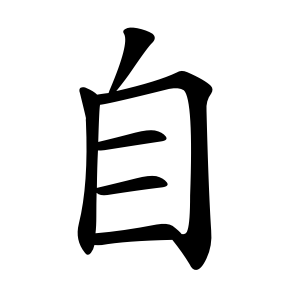自
- self, oneself;
It signifies "self" or "one’s own.
Etymology
The character 自 originally was a pictogram representing the human nose and is the root form of 鼻 (nose). However, before there was a specific character meaning "oneself" or "self," 自 was borrowed to mean "nose." Over time, the meaning of "nose" was lost for 自, and a new derivative character 鼻 was created specifically for "nose." This semantic shift happened long ago and became fixed, making 自 a classic example of a phonetic loan character (假借, jia jie).
Culturally and linguistically, in Chinese and Japanese traditions, the nose is often used to refer to oneself, which likely contributed to 自 acquiring the meaning of "self" or "oneself."
Additionally, in Classical Chinese, 自 also functions as a preposition meaning "from" or "since." For example, the phrase 自古 (since ancient times) uses this character, as does the construction 自A至B meaning "from A to B."
Usage in Korean
When used as a radical, it generally conveys meanings related to the nose, sense of smell, or breathing.
It is usually placed at the top part of a character, forming a vertical (top-bottom) structure.
Words that derived from 自
- 독자(獨自)–individual; distinctiveness
- 자각(自覺)–self-consciousness; awakening
- 자급(自給)–self-supply; self-support
- 자급자족(自給自足)–self-sufficiency
- 자동(自動)–automatic operation; automatic movement; being automatic
- 자동사(自動詞)–intransitive verb
- 자동차(自動車)–car; automobile
- 자동판매기(自動販賣機)–vending machine
- 자력(自力)–one's own efforts
- 자비(自費)–one's own expense; one's own charge; self-financing
- 자수(自首)–self-surrender; self-denunciation
- 자신감(自信感)–self-assurance; confidence
- 자아(自我)–ego
- 자연히(自然히)–naturally
- 자영(自營)–self-management
- 자유(自由)–freedom
- 자유롭다(自由롭다)–free
- 자율(自律)–autonomy
- 자작(自作)–one's own work; one's own making; independent farming
- 자작농(自作農)–owner farmer; independent farmer; independent farming
- 자작하다(自作하다)–make something by oneself; farm on one's own land
- 자족(自足)–self-contentment; self-satisfaction; self-sufficiency
- 자체(自體)–self; being own
- 竹月山 (HBU)
- ⿱ 丿 目
